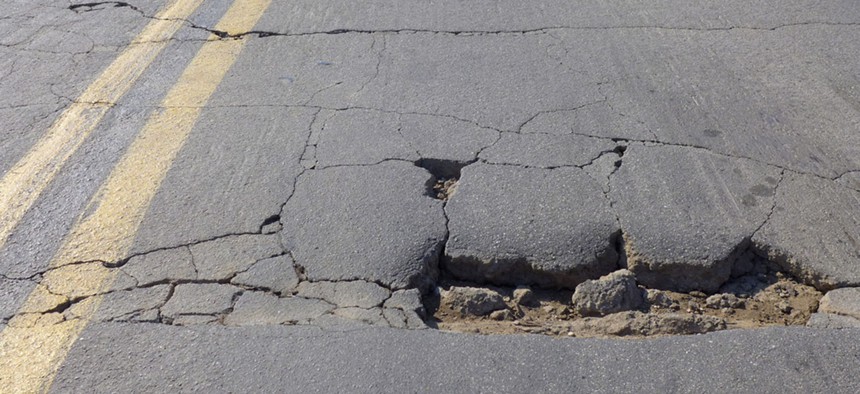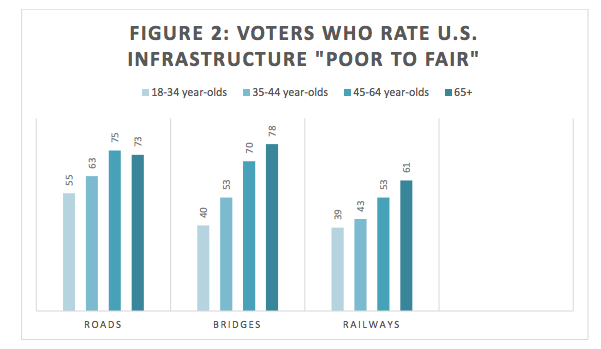
Richard Thornton/Shutterstock.com
Americans Really Want More Infrastructure Spending
A big majority of voters support it, according to a new survey. So why aren’t they getting it?
Decaying highways, pipes, and railroads aren’t only top-of-mind for the average CityLab reader—nearly half of registered American voters believe that the state of their country’s infrastructure has deteriorated in the last five years,according to a national poll conducted in mid-June by the Association of Equipment Manufacturers. The vast majority—80 to 90 percent—of the roughly 2,000 individuals surveyed believe that the nation’s highways, bridges, water and energy grids are in “some” to “extreme” need of repair.
The poll also reflected ideological and generational gaps, with a greater share of Republicans (53 percent) than Democrats (41 percent) saying that they felt the state of the nation’s infrastructure has gotten worse in the last five years.That division tracked with age differences: Older Americans (who are more likely to vote Republican) seem to have a particularly bleak view of conditions: Nearly three-quarters of folks older than 45 rated U.S. roads as “poor to fair,” while 63 percent of 35-44-year olds and 55 percent of 18-35-year-olds thought the same. Similar differences of opinion were found regarding bridges and railways. Younger respondents also placed a much higher importance on forward-thinking infrastructure innovations, such as vertical farms, autonomous vehicles and drones.

(Association of Equipment Manufacturers)
Still, respondents from across the political spectrum agreed on the need for increased action on infrastructure from all tiers of government. Roughly three-quarters of individuals surveyed wanted more from their state governments, while 72 percent and 70 percent wish federal and local governments, respectively, could do more. About 68 percent said that more federal dollars going into roads, bridges, and pipes would have a positive impact on the economy. Public transit systems were not included in the survey—thoughprevious surveys show that the majority of Americans support increased transit spending.
So how likely are these voters to get their wishes? Over the past 10 years, total capital spending on infrastructure has fallen in all but five states and the District of Columbia, and federal infrastructure investment over the past three decades has dropped from 1 percent to 0.5 percent of the nation’s GDP. The American Society of Civil Engineers has estimated that the U.S. faces an infrastructure spending gap of nearly $1.5 trillion, shared between all tiers of government. More than ever, that number has a human face on it: the lead-tainted water in Flint was essentially a direct result of a state cutting corners on infrastructure investment.
Both presidential nominees have said that they plan to budget hundreds of billions towards infrastructure projects, taking advantage of the current historic lows in interest rates. And Democratic nominee Hillary Clinton has received attention for repeatedly proposing a federal infrastructure bank that helps finance state and local projects. Other than his infamous wall, Trump has made few concrete proposals. But as the depressing saga of the (now effectively bankrupt) Highway Trust Fund shows, Congress appears uninterested in raising the money for infrastructure maintenance and improvements. “Unwilling to ask users or taxpayers to pay more for roads and other infrastructure projects, Congress has resorted to increasingly desperate and gimmicky proposals, including a proposal to capture a portion of repatriated corporate profits, and transferring funds from the Federal Reserve’s balance sheet,” CityObservatory recently reported, by way of explaining the essential unlikelihood of Clinton’s “i-bank” reaching success.
It’s a shame that this survey didn’t ask respondents if they’d be willing to pay higher taxes for better infrastructure, since their leaders in Congress seem to assume that the answer is no. Other polls have found that Americans would cough up more for road maintenance. A small but growing number of states seem to be listening—eight have recently made tax-raising moves to pay for road construction, and a couple more are even beginning to turn to per-mile driving fees. Meanwhile, public-private partnerships are becoming more common as a financing strategy for local public works projects. But from a national perspective, as long as revenue-generators such as the federal gas tax remain untouched year after year, the U.S. has a long road ahead to infrastructure worthy of the 21st century.






